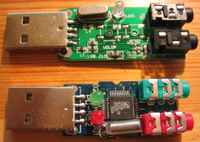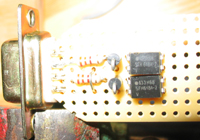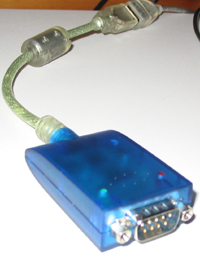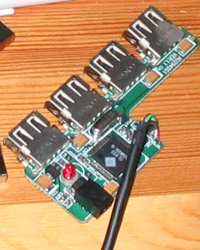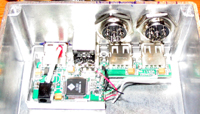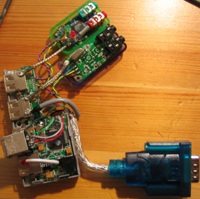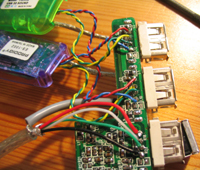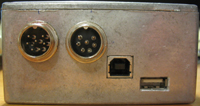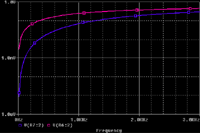Thoughts for the future:
The LED on the USB hub was directed through the USB socket on the outside to
confirm connection. There are also LED's on the audio devices, they light up
when the device has been detected by the computer and flash when the device is
in use, it would be handy to extend these to the outside for debug and
identifying which channel is 1 and which is 2, similarly it may be useful to
have a PTT active LED on the outside of the box.
The USB hub is not currently powered because the Audio and Serial devices
only take 100mA each, this leaves 100mA available on the external USB port, this
is fine for most mice, GPS receivers, etc. This all works fine provided the hub
is plugged in to a fully powered USB socket on the host system. One improvement
therefore could be to either have an external socket for power in (12 in to
internal 2-3A 5V regulator?) or use the spare/power pin on the radio connectors
to pass in some power. The positive side of a separate power connection is that
the box could be used as a power distribution point, then again you could go the
other way and miniaturise it into a box about half the size...
The Audio in on these devices is a mic input, they usually have an AGC
setting, this is best turned off. The input volume level required is very low,
only 3 or 4 % It may be preferable to have a 3:1 or 4:1 attenuator before the
mic in to make things a little easier to tune.
As there is a USB-Serial adapter in the box with only the handshaking pins
being used it may be an idea to run the TX and RX lines out to a serial port
connector on the end of the box, thereby giving a serial port that could be used
for configuring TinyTrak's or other equipment on a laptop without serial port.
I've not checked if AGWPE blocks the serial port when it's using it for PTT yet;
if it dosn't, great, if not you'd need to close the packet engine to use the
port but for initial setups it's a handy fallback plan.
With this particular setup the only drivers you should need to install are
the USB-Serial adapter ones, Windows XP handles USB audio devices without any
help, An up to date Linux distro in contrast should require nothing other than
plugging the box in :-) One tempting option that springs to mind however is
dropping the external USB port and using it for an internal USB flash drive, 1Gb
ones can be had for under £10 these days, even a much smaller one may be handy
in the box, it could hold the drivers for the serial device along with the
installers for AGWPE, UI-View 32 or any other commonly used software for the
APRS station. In this way a single USB cable from the box would allow setup of
an APRS system on a computer from scratch...
|

